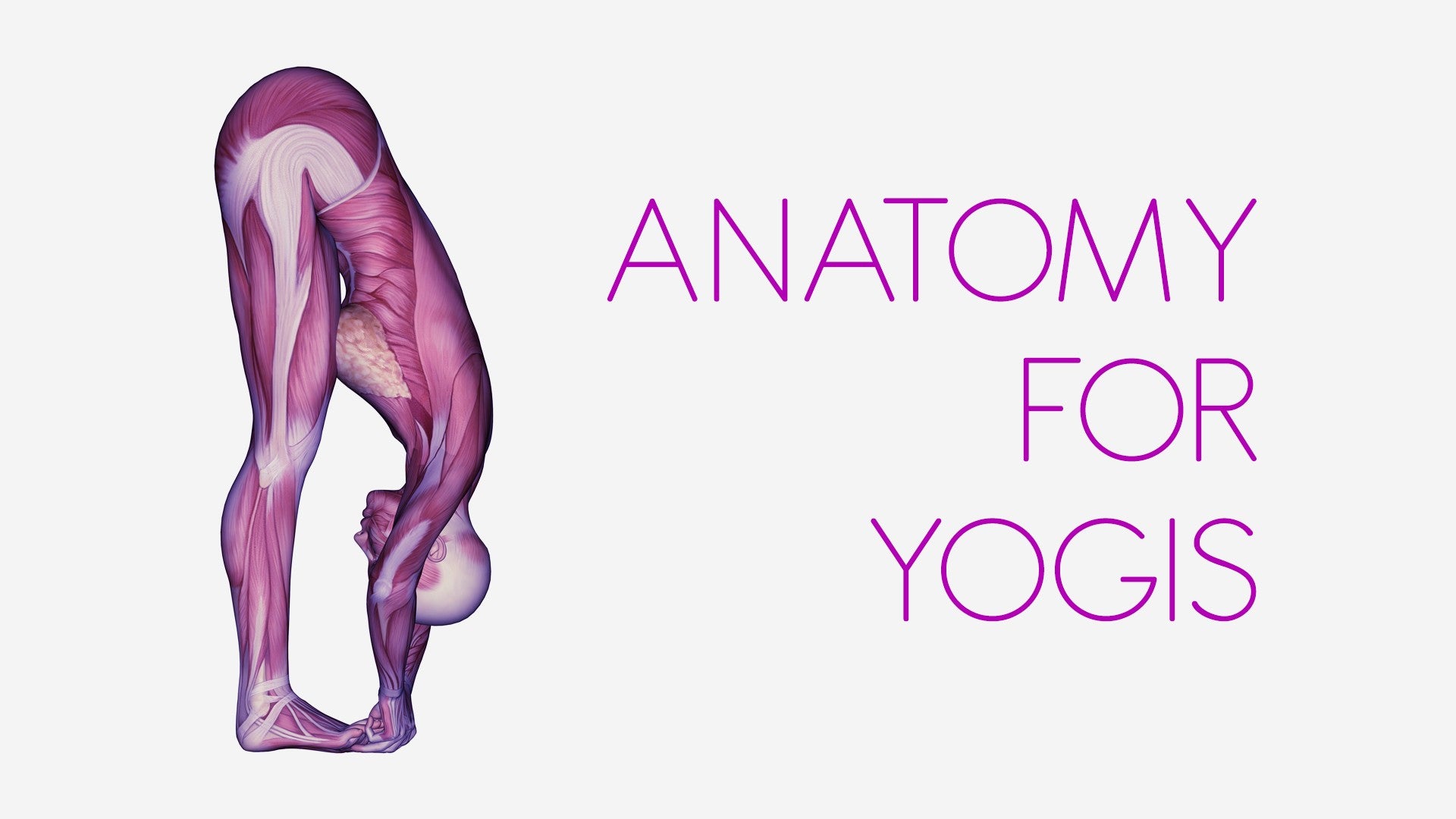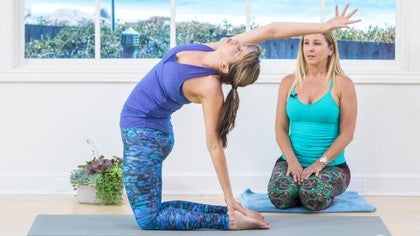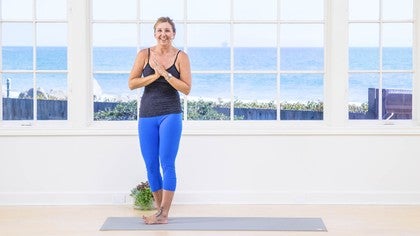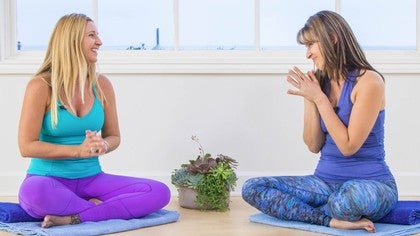Description
About This Video
Transcript
Read Full Transcript
Hi there, welcome back. I'm here today with Chelsea, and today's class is really one of my favorites. It's a reflection of most of my research from my master's thesis, which was about stretching. But in the process of learning about stretching, I had to learn a lot about biomechanics, and so I learned a lot about how joints function, and how joints adapt, and how we adapt to movement, and most importantly, how we adapt to forces, and how these forces can really mold the durability and strength of our joints. And so I started to question a lot of the sort of golden rules that we live by in yoga, and play with them a little bit. I have taken some variations of some very common poses, and so this is just a short collection of some new stuff, but it's all classical yoga poses that you'll know quite well. So the only thing you'll really need is two blocks for this. You will barely need a block, so if you don't have blocks, just go grab a couple books or something, just two solid structures that have a little bit of height to them. Okay, and we'll go ahead and get started. Are you ready? Okay, so go ahead and come on to all fours on your hands and knees, and let's just move through a few cat-cows to start to warm up the spine, warm up the legs, warm up the arms, and just pay special attention to the areas that like to move, areas that like to flex, and the areas that like to extend. And notice if one side moves a little bit more freely than another. I always notice in my own body that the muscles on one side work just a little harder. I like it, but I can always feel there's a little imbalance, and just teaches me about some of my patterns, how I like to stand, how I like to hold myself. And then go ahead and come all the way back into child's pose after your next cat pose, and then reach for your blocks, and you'll come back up, and you're going to put one block under your left hand and the other block under your right knee. Set yourself up on all fours again. The back toes of the right knee can be tucked under or flat, whatever is comfortable for you. There's no rule here. And now move through Cat-Cow. So this is our first variation of a common yoga warm-up, and you'll find there's a whole different way of being in your spine. There's a whole different way of flexing and extending because you're a little bit off-centered, you're a little bit rotated. And just see where the sensations lead you, right? See what's different here. Just do one more. Notice which side's working harder, and does that change as you change direction? And then go ahead and switch. Put the block under your right hand, put the other block under your left knee, and do this side. Cat-Cow. Observe if you notice that this side is a little bit more enjoyable for you than the other side, or if it was the first side that you liked. Because of the shape of the spine, because it's curves, in a twist there's always some aspect of a side bend. And so when we move through this sort of twisted version, sometimes we can either reinforce or unravel some of our own natural side bend twisting postural habits. So you might find that you are gonna, in your own practice, prefer to do one side, but not do the other side with the blocks. Especially if you have scoliosis, sometimes this works really well for people just to change their experience in the way that their spine is held. Just go ahead and do one more. Finish in cat pose. Remove the blocks. Go ahead and just do one Cat-Cow neutral so we don't leave you feeling totally crooked. And then the next time you make your way into cat pose, go ahead and push back into a child's pose. And just rest. You can make a pillow with your hands or do whatever you need to. Just take a moment to check in. And then go ahead and press yourself up. And go ahead and have a seat with your legs stretched out in front of you, like it's Upavishta Konasana.
And bring your hands to the inside between your legs. You'll just arch your spine and sort of walk your fingertips forward so you can do Cat-Cow seated here. Go as far forward as you can. You might be limited by your hamstrings, so don't worry about that. And then round your spine so you're doing Cat to come back. And you can slide your hands back or walk them back, whatever is comfortable. And again, arch your spine forward and round your spine back. And one more. Arch forward and see if you can use the whole spine so you can sequence this throughout all the segments of your spine. And then when you round back, your whole spine is sort of bowing back and then come straight up. Now turn over your right leg so you're twisting to the right. And now in this twisted position, make sure you haven't side bent too much because that's that's my trick. I love to side bend and it looks like I'm twisted. So you can really rotate the ribs over the pelvis. And then from here in this twisted position, extend and flex. So you'll extend by arching forward and you'll flex by rounding back. Stay twisted. Keep that right side of your body long as you go through this. The spine can move in incredible ways. And I notice in yoga we spend a lot of time in teaching hip flexion which is a very important skill. But we end up sort of just keeping our spine in this neutral position and then very rarely do we actually flex. And then we extend for back bends but very rarely do we flex. But we never flex in a twisted position. And you'll notice that this gives good proprioceptive feedback to the tissues in the back of the body in the lumbar dorsal fascia. And then go ahead and come back and then we'll do the other side. So from the center you'll come neutral and then twist to your left. Notice if you tend to side bend and then arch extend forward. Keep that opposite hip grounded and then round to come back. And immediately you'll notice you favor one side. You use the strength of your arms to help initiate the movement but really feel the spine moving. So don't arms do all the work. This is your last one. And then please just do one more through the middle so that you're neutral or as neutral as you can actually be. And then go ahead and bring your legs together. And let's set up for a downward dog. So how we'll vary this downward dog is we'll take our hands as wide as the mat and our feet as wide as the mat. And then from this position I'll have you come forward into plank even though you're wide and then pull back into downward dog. And again come forward into plank and come back into downward dog. And then come forward into plank and go ahead and with your hands right here and your feet right here lower all the way to the floor. Nice and slow. Really really slow. You're using you're totally using a different line of muscles in order to get down so it's gonna feel very strange. Untuck your toes and low cobra here. Feel very very different right? And then tuck your toes under push up to plank from here and go all the way back into downward dog. Take a few breaths here you can go ahead and bring your feet back to the position that you're comfortable in and your hands back into the position you're comfortable in. You know that we spend so much time mastering a perfectly aligned plank. It's like one of the first things you learn when you come to yoga. But if you trip and fall what are the odds that you land in a perfectly aligned plank? So you want to be able to train not only the muscles but the joints so they can adapt to be strong in different novel joint positions and also your nervous system. You want to make sure your nervous system knows what it feels like to be in a plank other than a perfectly aligned plank. And then go ahead and lower your knees down and rest in child's pose. Go ahead and climb yourself from here all the way onto your stomach. Come up onto your elbows for Sphinx pose. So your elbows will be underneath your shoulders your wrists right in front of the elbows. Pull your chest forward we're all very familiar with this pose. Feel your erectors the spine the muscles parallel to the spine working to keep you in this spinal extension. Now can you stretch your right arm straight forward off the ground without lifting your pelvis on one side or without shifting your weight over to the left side? So now you're having one side having to think a lot harder than the other side. Nice and then go ahead and come down and switch left arm goes forward. Really think can you stabilize allow yourself to work harder on your right side and then go ahead and put that left arm down. If that's a challenge if you fell all the way over to one side or you just couldn't even manage it it takes a little bit of getting used to so one of the ways that you can modify this is to keep your fingers on the ground and just cup your fingers. So we'll do it again so you can try this if you prefer otherwise you can stretch your arms straight up. Chelsea will walk her hand forward and cup her fingertips on the floor the arm will be straight. So now she has the ground to get a little bit of leverage you might find this easier or not and then bring that elbow down and switch sides and then come back pause for a moment in the even sphinx and then go ahead and bring your forehead all the way down. Bring your hands underneath your shoulders tuck your toes under either push through all fours or plank and come all the way up to downward dog and then from downward dog slowly walk your feet forward toward your hands and pause in uttanasana for a moment and then from uttanasana go ahead and slowly roll your way up to standing bend your knees and slowly roll up one vertebrae at a time and then go ahead and grab your block and place it at the top of your mat under your right foot you'll put your right foot right on top of it and you'll stretch your left leg back for warrior one you can start with your hands on your hips and then from here go ahead and stretch your arms all the way forward and up you're pausing and warrior one if this becomes too much for the arms feel free to place them back on your hips we're gonna work the front leg just a little bit so go ahead and straighten the knee just a little and now when you bend the knee can you move it over the fourth and fifth toe mm-hmm and then go ahead and bend straighten the knee again just a little bit and then bend it this time over the big toe and then go ahead and straighten the knee just a little bit and bend it over the second and third toe like you're used to but again the knee is not just a hinge joint and if we never train it in a little bit of different joint positions then we never train it it never becomes adaptable so you'll repeat that one more time straighten your right leg just a little and as you bend it you're just going through resistance like this is to be a strong pose you can't just flop the knee around that's not enough to adapt you have to engage all the muscles in your legs like you're moving through something with resistance straighten the leg and then go ahead and move toward the big toe you can actually imagine that I was out in front of you and I was trying to prevent you from straightening the knee and then that I was trying to prevent you from bending the knee so that will help you activate the muscles in the legs which will help that knee joint and then pause with your knee just pointing over the second and third toe and then go ahead and lower your arms and step all the way up good switch sides put the block under your left foot be careful here if your blocks you know it's a little different you're kind of balancing on something so I was like to step back into these poses once you're grounded in both feet go ahead and stretch your arms straight up and we'll do this on the left side so go ahead and straighten your knee just a little bend the knee over the fourth and fifth toe and you'll notice that it's such a subtle change but it's an entirely different movement process you're gonna feel this in a whole new area in the leg and then go ahead and straighten the knee a little bend over the big toe so you're moving with control you're not just letting the knee sway from side to side and then bend the knee over the second and third toe and we'll repeat straighten the leg move over the fourth and fifth toe and then straighten the leg bend over the big toe again you can imagine that I'm I'm holding the front of your knee in the back of your knee keeping you from doing the movement so you really work hard and then go ahead and bend the knee and just hold there for a moment pausing just a couple breaths in the talk like me little video I talked a little bit about what it's like to contract maximally strongly so you might want to check that out and then bring your hands down and come all the way up go ahead and take the block between your hands go and stand all the way up take the block between your hands stretch your arms straight out in front of you and then from here go ahead and bend your knees sit back in Utkatasana stretch your arms overhead so the block here is just to help you get the sense of lifting as your legs lower down here you are in Utkatasana now I'm going to challenge you to experiment with an Utkatasana you are unfamiliar with so straighten your legs change the position of your feet just do something and then Utkatasana whoa super hard sit in it just for a little bit feel the pose like this is real this is what happens when you step off a curve when you're walking down the street we're not always perfectly aligned go ahead and straighten do something different with the legs something totally unusual Utkatasana oh crack all right now I'm not saying throw alignment to the wind like I strongly believe you should be able to be aligned but you should also be able to be misaligned so I'm not saying oh forget it nothing matters everything does matter go ahead and come up step your feet together do the Utkatasana you love so much and are so familiar with you're just comfortable with it because you know it so well and then go ahead and stand straight up lower the arms and just rest for a moment okay you're done with your block now and then from here I'm just gonna have you roll down nice and slow leading with the head roll down one vertebrae at a time make your way all the way down to the floor good once your hands are down go ahead and step your feet back into a downward dog and then just for the fun of it move one hand farther forward move the opposite foot further back so you're feeling this diagonal stretch across the back and then come back to your squared downward dog and switch right hand goes forward left foot goes back and then bring both hands back to neutral feet back to neutral and go ahead and lower your knees down and rest in child's pose okay and then from here go ahead and climb your way onto your belly once again bring your elbows down for Sphinx I'm tricking you tuck your toes under and lift up into forearm plank okay so here you are in forearm plank we're gonna play with some variations so can you shift your shoulders over to the left a little and can you shift your shoulders over to the right and to the left and to the right and just go back and forth between the two and this is one of my favorite approaches to forearm plank and it for all the same reasons right it's training the shoulder joint and it's just a little bit of an off centered position don't go too far don't force it but also you'll feel that your your core muscles will contract in order to help stabilize you so you get this great understanding of what it's like to experience a little bit of perturbation good go one more to your right and then pause and rest you can just lay on your stomach make a pillow with your hands because we have more variations of that this is one of the things I teach before I teach headstand because I would much rather you learn to sway a little bit off-center here with your feet solid on the ground rather than when you're standing on your head it's just a really great way to teach your body how to capture itself when there's just a little bit of off-centered off-centeredness okay one more time forearm plank come come into it however you can and let's do a little bit of rotation so turn your pelvis to face the left now so you're rotating just keep on the balls of your feet and then rotate to the right good and just repeat that this is another great one it's like a spine massage I just love it side to side finish facing the right and we'll add one more pause facing down now can you make some circles with your pelvis so up but left down and around up left down around to the right you're just continuing to make a circle if your arms are dying take a break switch directions please it's not easy because we're used to holding right we can hold the plank for 10 minutes after a lot of training but we're not used to moving in our planks and then come back to the center and rest make a pillow with your hands slowly push your way back into child's pose and then Chelsea I'll have you move forward on the mat a little bit even more so now we're gonna do a little variation of camel you will place your left hand on your heel so you're gonna have to lift your pelvis just a little and you stretch your right arm out in front of you and you're gonna come all the way up into like a side camel so you're gonna lift your pelvis up push it forward your arm right arm is gonna go up and you do a nice big back bend so you're sort of twisted in a back bend and then come all the way back down into a child's pose and switch arms you'll do each side three times you'll hold on to your right heel stretch your left arm up push the pelvis forward and come all the way up and it's sort of this oh nice there's another pop again it's a nice unilateral version of these backbends it feels so good against great spine massage these are ranges of motion that we don't often explore in our yoga practice oh and one more time each side and after you've finished the last side you'll come down and rest and child's pose go ahead and stretch your arms out in front of you make your way up to downward dog and this time bring your feet all the way together lift your heels a bit and separate the heels toes are sort of coming toward each other and this should feel really good on the lower back after those back bends if you're near a wall you can always back up to a wall and put the heels on the wall it feels really good too and then go ahead and bring the heels back together separate your feet good come forward into plank and lower all the way down to the floor great one more time Sphinx pose elbows down we're gonna do some hamstring work if the the work that we do creates a little bit discomfort in the lower back you can easily just go ahead and put one hand on top of the other and rest your head down on your hands I like it this way I know Chelsea does too but you're you know you don't have to do it this way you can always rest in a complete prone position so let's start the right leg so bend your right knee flex your foot and then from here you're going to work as hard as possible to slowly draw your heel in toward your glutes so you're contracting these hamstrings pretty maximally it's like there's something giving you some resistance push push put it into me uh-huh so it's like I'm holding you from coming in but you're working really hard and then with resistance again like someone's preventing you from going back to 90 you'll go back to 90 and then again flex in pulling your heel all the way toward your pelvis and you'll notice you might have some wild swings it's just a little lack of motor control in this position and then go back to 90 you might also get some cramping that's okay and then pull the heel in one more time and then this time when the heel is all the way pulled in as far as it'll go can you from here lift your thigh bone off the floor but don't lose the hamstring contraction so now you're co-contracting with your thigh bone lifted can you point your foot but keep pulling your heel in toward your glutes and then with your thigh lifted can you slowly kick the leg as straight as possible with the thigh lifted this is a lot of work in the legs it's my what I like to do to teach backbends really good work for the legs to show what the legs have to do in order to stabilize you for a backbend and then slowly lower the leg down and then you can just kind of flop it around give it some love get some blood flow in there do what you need to do and then let's do the left side so bend your knee pull your heel in toward the pelvis and it's not just a casual flopping of the leg you're really using muscles you're creating some of your own resistance your own internal tension a lot of good stuff happens in resistance stretching and eccentric stretching good when you go back to 90 pull in again so you just do three of those the first one's usually enough but we really want to get the experience of work and then come back to 90 and then one more pull all the way in and once you're pulled in as far as you can from here start to lift the thigh then point the foot keep pulling in though keep pulling in toward the pelvis and then slowly with the thigh lifted don't let it drop down start to straighten the leg we spend so much time in yoga stretching our hamstrings we forget to strengthen them this is so important and this exercise strengthens them at a short and long range how do you feel now from here go ahead and bend your knees up and you'll move your way into Dhanurasana but you can't use momentum for the first one so don't reach with one arm and then the other go ahead and come down onto your forehead from here reach your hands back by your hips and now can you start to lift your thighs up off the mat and can you use strength to reach back and reach for your ankles so you're actually getting yourself into this position rather than using momentum to find your way there and then strengthen so keep reaching back keep reaching back don't pull your heels in just lift the thighs as much as you can lift the back as much as you can and then slowly come down and rest okay now you can use momentum bend your knees go ahead and come into Dhanurasana any way you like although usually when I teach this out on the road people love it so much because they love the strength aspect of it that they actually don't just use momentum in the second time around you might be very happy to play with the new version and slowly make your way down this is just one of the best poses out there I think I love it and then make a pillow with your hands and turn your head to one side just let the legs kind of wobble with the pelvis shake a little and then tuck your toes under push your way back into a child's pose with your toes tucked under so you don't go into lumbar flexion just yet and then slowly go ahead and make your way on to your back keep your knees bent up and your feet flat on the floor move down just actually you're good there and then go ahead and cross your right ankle over your left knee let's do a reclined pigeon so thread your right hand through the circle you just created hold on behind you the left thigh or the left shin just allow yourself to be in a nice gentle passive stretch here for a moment and then in the right hip start to create some resistance and start to to almost try to come out of the pose but something's keeping you in the pose so the deep hip muscles the lateral hip muscles are actually working here so you've pulled them into a stretched position and now you're contracting them should feel really good on the hip and should feel great on the lower back as well and you're probably pretty tired from that so go ahead and rest and then one more time start to contract the muscles only sustain it for about 15 seconds usually it doesn't have to be long just really target that you feel those muscles working and you'll actually feel a greater sense of stretch and then relax pull your knee in just a little bit more if it feels good for you get that superficial gluteal stretch and then slowly come down and switch legs left ankle goes over the right knee left hand goes through the circle you created hands go behind the thigh or the shin whatever is comfortable and you just go to go to not your end range per se but just let yourself pull in a little bit still you feel a gentle stretch and now contract the muscles and you'll experience that the sensation of stretch actually increases this is a isometric hold at your end range or close to your end range and then relax and then again create some internal resistance like you're trying to push your left leg out of the pose but you're still in the pose and slowly relax and then go ahead put both feet down on the ground and rest slowly make it your way up to seated you can do this either rolling over to your side or just rolling up whatever is comfortable for you and then join the soles of your feet together I'm going to do this pose with you because I love it join the soles of your feet together and go ahead and just come forward into bado konasana and you're just holding your ankles you can allow your spine to round a little bit here and then go ahead and come up and change the position of your feet because I my guess is you do bada konasana the same every time you do it so take your feet further away or closer in whatever is comfortable and then come forward it feels completely different it's like whose legs are these and then come up and stagger imagine that your feet were together but bring one closer and one further and come forward and allow your pelvis to shift to accommodate and then try staggering the opposite way and then when you want to end you'll just come back to your favorite familiar old shoe bado konasana the way you're used to it come all the way forward allow your back to round just a little and then slowly make your way up and make your way onto your back for shavasana notice if there's any final movements you want to make go ahead and take them now observe how you feel you did all very very common everyday yoga poses with lots of different variations this came about for me because those of us that love our yoga we practice our yoga all the time it's oftentimes the only thing that we do I know that yoga was my life for about 20 years and I became very adapted to yoga really good at yoga but I didn't get good at a lot of other stuff a lot of other joint positions and so in order to be able to keep doing my yoga as much as I like to I decided to add some variations so that I was adaptable to different things I still now actually practice other modalities as well but yoga it can be a very very sustainable practice and it can actually help you move better if you'd like to rest in shavasana for seven or eight minutes I would recommend that if you're interested in doing a body scan we have one of those up here on yoga anytime it's a five to ten minute walk-through of how you feel in your body one of my favorite ways to end a practice and if you'd like to come up and close the class with us we'll do that by stretching your arms overhead and stretching stretching stretching reaching and then allow your body to stretch however it wants what if you pull with more with one arm what if you reach more with one arm and more with the other leg I don't know you make it up your body knows what it needs just like your cat your cat knows what it needs right so just be a cat just stretch and feel and then when you're done playing with that bend your knees up roll over to one side put your hand on the floor in front of your chest slowly roll yourself up to seated find a comfortable cross-legged position close your eyes from top to bottom join your palms together at your chest gently bow your head down acknowledge the amazing ability that you have to move in the infinite amount of ways that the body can move and then slowly lift your chin release your hands and open your eyes thanks for joining us thanks Chelsea namaste
Anatomy for Yogis: Jules Mitchell
Comments
You need to be a subscriber to post a comment.
Please Log In or Create an Account to start your free trial.















